- Published: 29.07.2004.
Joint Statement by foreign ministers of eight Stability Pact partners

On the 5th anniversary of the Stability Pact, the Ministry of Foreign Affairs publishes the text of the Joint Statement by foreign ministers of eight partner countries of the Pact, signed 8 June 2004 at the meeting in Portorož, Slovenia
Today, five years later, South Eastern Europe paints a different picture. The democratisation process in these countries is irreversible. And although the economic situation is far from ideal, important foundations have been laid so heavier foreign investments can be attracted, though it is unequally divided within the region. Fierce conflicts such as those from a few years ago, are history. The focus has been shifted to fighting organised crime and corruption, like elsewhere in Europe and the world.
The heritage of conflict is still felt. We deal with it gradually, but it can only be overcome through joint efforts, by setting up a framework that would allow the refugees to return to their homes, by rebuilding trust between the armies that were locked in conflict a few years ago, by rebuilding the foundations for economic growth. Improved regional stability, especially through the Stability Pact, is the foundation for a positive outcome.
The Stability Pact ensured a neutral forum for discussion in a post-war period when direct bilateral contacts were politically unworkable. It facilitated talks with the chief donators who were willing to help our countries.
The Stability Pact still plays an important role in promoting regional stability, complementing the Stabilisation and Association Process and contributing to the implementation of the decisions from the EU Thessaloniki Program for Western Balkans, June 2003. Prospects for a European and Euro-Atlantic integration are the guiding principle for all of the Stability Pact countries. Bulgaria and Romania’s entry into the EU 2007 will strengthen the SP countries’ prospects, and Croatia’s candidate status will further motivate the SE European countries to continue with the reforms. Macedonia’s membership application, Albania’s progress in negotiating with the EU about the SAP, as well as the efforts of Bosnia and Herzegovina and Serbia and Montenegro to meet the required criteria for the start of the negotiation with the EU about such an agreement, are further proof of progress in the region. Within the framework of European integrations, certain political and economic criteria must be met as well as maintain the principle of diversity. The conclusion of the EU Action Plan for Moldavia is to confirm the positive role of the Pact in the process of Moldavia’s approaching the EU.
Although stability in SE Europe has been reached and the Pact has thus achieved its goal, is will remain an important forum. Regional co-operation and finding the common solutions to common problems is the foundation upon which the EU was built, and to a certain extent NATO as well. The Stability Pact is an important polygon in view of our common goal – European and Euro-Atlantic integrations.
The Joint Statement was signed by: Albanian Foreign Minister Kastriot Islami, Bosnia and Herzegovina’s Foreign Minister Mladen Ivanić, Bulgarian Foreign Minister Solomon Passy, Croatian Foreign Minister Miomir Žužul, Macedonian Foreign Minister Ilinka Mitreva, Moldavian Foreign Minister Andrej Stratan, Romanian Foreign Minister Mircea Geoana, and Serbian and Montenegrin Foreign Minister Vuk Drašković.


